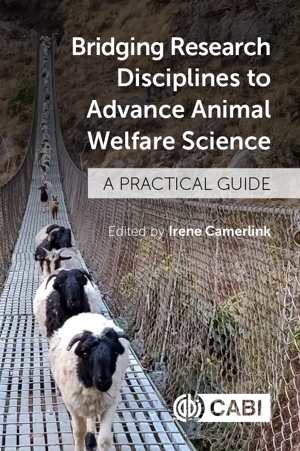Bridging Research Disciplines to Advance Animal Welfare Science
By Irene Camerlink (Ed.)
| Record number: | bd12b |
|---|

This book gives guidance on how cross-disciplinary research can advance animal welfare. With numerous examples and case studies, the text explains:
· the different concepts regarding cross-disciplinary research
· how to set up cross-disciplinary research projects
· how to work in cross functional teams and models for effective team working
· how different fields can impact animal welfare, including social sciences, neurosciences, genetics, behavioural ecology and technology.
The aim of the book is to help researchers and graduate animal science students to understand how to advance animal welfare through the integration of disciplines.
ISBN: Paperback: 978-1-78924-789-3, Hardback: 978-1-78924-788-6, ePDF: 978-1-78924-790-9, ePUB: 978-1-78924-791-6
288 pages.
Price: £85.00 (hardback): £39.99 (paperback, ePub, ePDF)
Table of Contents
- Section 1: Crossing disciplines
- 1: Interdisciplinary research to advance animal welfare science: an introduction. Irene Camerlink.
- 2: Pragmatics for crossdisciplinary collaboration. Julie Thompson Klein.
- 3: Doing animal welfare transdisciplinary research with stakeholders; advantages, pitfalls and hands-on solutions. Tjard de Cock Buning and Marianne Benard.
- 4: Interdisciplinarity and the dilemmas of knowledge. Robert Frodeman.
- Section 2: Applying other disciplines in animal welfare research
- 5: Human-centred research approaches to improve animal welfare: survey design and stakeholder involvement. Grace Carroll, Jenny Groarke and Lisa Graham-Wisener.
- 6: Human behaviour change models for improving animal welfare. Grace Carroll, Jenny Groarke and Lisa Graham-Wisener.
- 7: Applying economic models to assess the viability of animal welfare interventions. Rachel S.E. Peden and Faical Akaichi.
- 8: Application of psychometrics to assess quality of life in animals. Jacky Reid, Andrea Nolan, and Marian Scott.
- 9: Behavioural tests for learning and cognition in humans and animals. Rebecca E. Nordquist.
- 10: Using neuroscience for better understanding animals and their welfare. Irene Camerlink.
- 11: The microbiota-gut-brain axis in determining social behaviours of animals. Nienke van Staaveren, Paul Forsythe, Jerine A.J. van der Eijk, Dietmar Fuchs, Johanna M. Gostner, Claire Mindus, Bas T. Rodenburg, and Alexandra Harlander.
- 12: Improving animal welfare using genetic and genomic tools. Wendy M. Rauw, Jack C.M. Dekkers, Luis Gomez-Raya.
- 13: Epigenetic tools to identify stress and exposure to detrimental conditions in production animals. Carlos Guerrero-Bosagna.
- 14: Using principles from behavioural ecology to address animal welfare issues. Gareth Arnott, Victoria E. Lee and Simon P. Turner.
- 15: Practical considerations for the use of Precision Livestock Farming to improve animal welfare. Janice Siegford and Kaitlin Wurtz.
Year: 2021
Takk for din tilbakemelding! Vær oppmerksom på at vi ikke kan kontakte deg hvis ikke du oppgir din epostadresse.
Hva lette du etter?
Gi oss gjerne en tilbakemelding slik at vi kan forbedre informasjonen på siden. På forhånd takk for hjelpen! Vennligst skriv inn din epostadresse hvis du vil ha et svar.
Kontakt oss gjerne på e-post hvis du har spørsmål.
